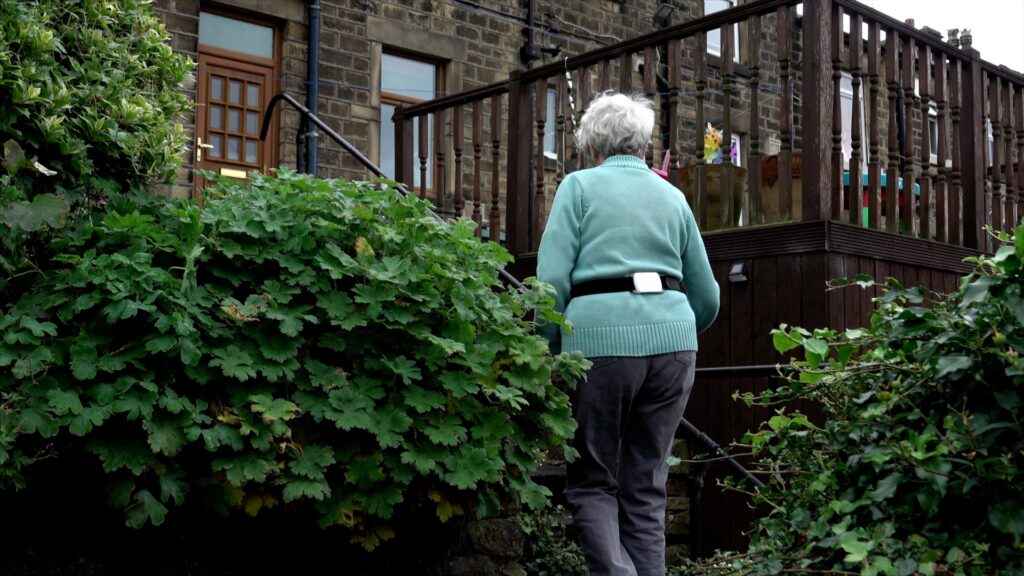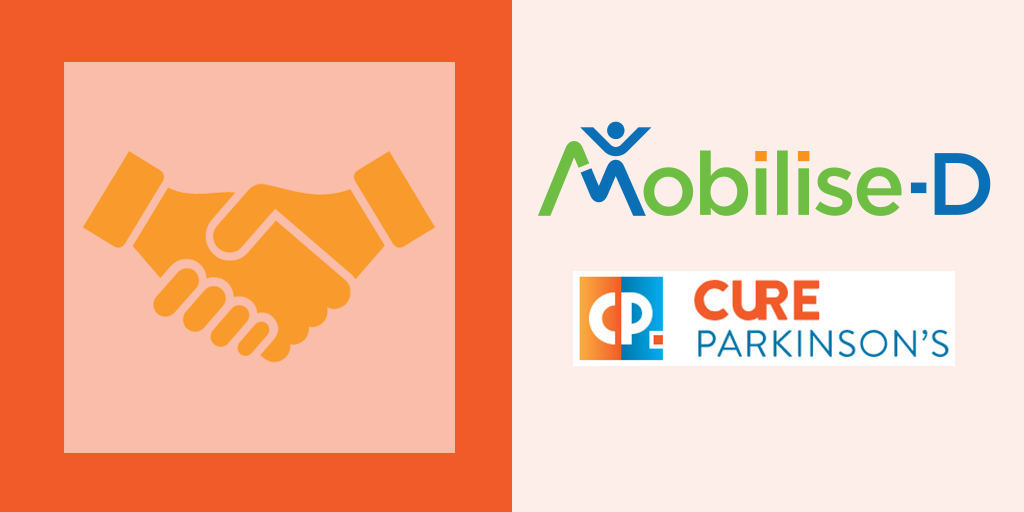We are excited to announce our strategic partnership with Cure Parkinson’s UK, working closely together to bring our research and clinical studies closer to patients and the public. We asked Helen Matthews, Deputy CEO of Cure Parkinson’s, to share with us her vision about the benefits of the research and clinical trials in Parkinson’s Disease, and the collaboration with Mobilise-D.
There is a huge debate about what to measure in Parkinson’s clinical trials and how to measure it. In recent years, the majority of clinical trials of potentially disease modifying agents have used one or more aspects of the MDS UPDRS (Movement Disorders Society-Unified Parkinson’s Disease Rating Scale) as the primary outcome. The MDS-UPDRS scale was developed by clinicians to provide a snapshot of the condition in a clinical setting. However, trial participants report that these clinical scales have little significance to their 24/7 lived experience of their Parkinson’s, for whom many the non-motor aspects of the disease are much more troublesome.

Too many of these trials have failed to produce a significant result which raises the question of whether the primary outcome measures being used are sensitive enough to pick up subtle changes in disease progression.
As has been highlighted in so many papers, the field of research focused on Parkinson’s disease modification urgently needs a measure of change in Parkinson’s that is important to three key audiences:
- people living with Parkinson’s
- clinicians
- regulators (who need to be certain that a drug is affecting positive change)
We need to find consensus with these three groups around selecting a domain of disease that is relevant for people living with Parkinson’s, measurable clinically, and that can be confirmed by digital measures with reliable validated algorithms. The measurement of this domain needs to be acceptable to regulators by measuring functional change, and with that the ability to perform selected activities of daily living.
All trials include a battery of secondary and exploratory outcomes, such as bio-samples and imaging analysis to provide biochemical evidence to support a hypothesis. However, there is another area that needs an imaginative solution.
People living with Parkinson’s can experience such a wide range of symptoms, and the impact of those symptoms changes with duration of the disease. The priority order of which symptoms are the most troublesome also changes with time. We need to find effective ways of capturing each person’s lived experience of Parkinson’s during a trial. This is where inspiration is needed – to create a holistic measure that resonates with trial participants and is easily to complete or comply with, that provides essential supplementary information – and would allow patients to feel as if their experience has truly been captured.

Honing in on what to measure
A recent paper in the Journal of Parkinson’s Disease by Ira Shoulson and colleagues comments that postural instability symptoms arise relatively early in PD compared with cognitive symptoms. Symptoms that relate to postural instability (such as gait, balance, freezing, and falling) could represent meaningful and detectable patient-reported outcomes for interventional trials. Shoulson used data from Fox Insight, developed by the Michael J Fox Foundation, which captures the variables that affect people with Parkinson’s and records what participants feel and experience.
This resonates with the statement below from a patient living with PD:
“Walking with PD ceases to be the automatic function it once was. On a good day when the medication is at its most effective, walking is often characterised by small rapid steps bordering on shuffling. When the medication’s effects are fading or just not working, I have to concentrate on setting up an internal metronome to give my limbs the impulse to move. In my case, as a forces veteran, I give myself a whispered order to “quick march”. Freezing is a further difficulty. However, as hard I try to continue moving forward I just come to a halt. Walking has become an activity requiring a great deal of physical exertion requiring focus on nothing else. Don’t ask me about multi-tasking.”
David M.
Gait, balance, freezing, and falling also have clinical significance and can be detected in MDS-UPDRS parts 2 (patient reported aspects) and 3 (clinical assessment). Additionally, they have the potential to be measured objectively using sensors. Reducing the impact of emerging symptoms of gait, balance, and falling would represent a clinically meaningful benefit.
Could we gain consensus around aspects of postural instability?
Interestingly, Silvia Del Din and colleagues reported in 2020 in Annals of Neurology that gait analysis with wearable sensors predicts conversion to Parkinson’s and that gait characteristics could, in conjunction with other assessments, be a prodromal marker for Parkinson’s.
If postural measures, and gait specifically, are sensitive enough to change in a prodromal cohort – will it be sensitive in a group of people with a confirmed diagnosis of Parkinson’s?
And this is where Mobilise-D comes in. Mobility – how well we walk – is an important marker of health; a slow walking speed is associated with greater risk of mortality, morbidity, cognitive decline, dementia, and falls. As the population ages, the number of people experiencing mobility challenges is expected to rise. However, accurately assessing people’s mobility, especially in real- world daily life, is far from easy.

Mobilise-D is developing a comprehensive system to monitor and evaluate people’s gait using digital technologies, including sensors worn on the body. The Mobilise-D results will help to improve the accurate assessment of daily life mobility in clinical trials and patient treatment, so contributing to improved and more personalised care.
As this project develops there will be opportunities for people living with Parkinson’s and their care partners to get involved – to find out more, please join the webinar led by the project team on October 5, 2022: https://www.mobilise-d.eu/webinar-series-mobilise-d-presents-its-four-patient-cohorts
One of the goals of Cure Parkinson’s is to listen to the needs of the patients and work in collaboration with world-class researchers, clinicians, pharmaceutical industry, and medtech industry to find new treatments for Parkinson’s disease and translate the research into clinical practice and to patients as fast as possible. David J. shares his story with us that motivates us to go further and prioritize together the development of new treatments.
“Before PD I never thought about walking. One puts one foot in the front of the other. It was completely natural and thoughtless rather like breathing. The first thing my best friend noticed was how my right foot dragged in the dirt when walking.
As PD advanced my feet started to shuffle. Both of them, one after the other. If I got off balance, there’s no way my feet could catch up with my head! No matter how quickly I moved my feet, I would end up falling flat on my face. On one memorable occasion I head-butted a butler’s sink splitting my head open. Walking with Parkinson’s is no barrel of laughs!
Next step! No pun intended was a complete inability to take a step.
I would go from fully mobile to rooted to the spot unable to move for as long as it took for my medication to kick in. Bizarrely I learnt that I could walk backwards. Whenever my feet were lodged in one spot and I couldn’t move them at all going forward, I could always go backwards.
The only problem with this is the major very strange looks get walking somewhere backwards.
The impact of all this is planning every journey, having a back-up plan should you freeze. Not going somewhere you want to go to because you can’t move and you missed the timeslot. It’s led to my coining the phrase “when I’m moving, I move”. It was better to get there early than not at all. Even if I had to walk backwards I decided it was better to arrive then not arrive.
It’s amazing how much you have to think about when walking with Parkinson‘s.”
David J.
Remember to FOLLOW us on Facebook, Twitter and LinkedIn.
Subscribe to our Newsletter.




